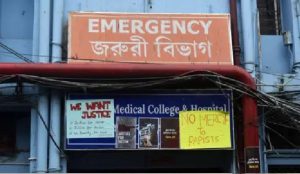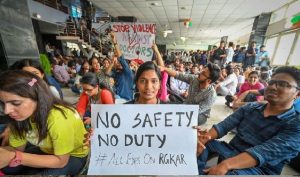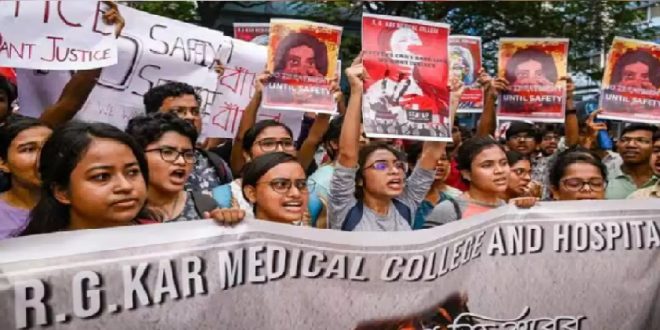15-08-2024
Bureau Report + Agencies
NEW DELHI/ KOLKATA: Early on Friday morning, a 31-year-old female trainee doctor retired to sleep in a seminar hall after a grueling day at one of India’s oldest hospitals.
It was the last time she was seen alive.
 The next morning, her colleagues discovered her half-naked body on the podium, bearing extensive injuries. Police later arrested a hospital volunteer worker in connection with what they say is a case of rape and murder at Kolkata’s 138-year-old RG Kar Medical College.
The next morning, her colleagues discovered her half-naked body on the podium, bearing extensive injuries. Police later arrested a hospital volunteer worker in connection with what they say is a case of rape and murder at Kolkata’s 138-year-old RG Kar Medical College.
Enraged doctors went on strike both in the city and across India, demanding a strict federal law to protect healthcare workers. The tragic incident has again cast a spotlight on the violence against healthcare workers in the country.
Women make up nearly 30% of India’s doctors and 80% of the nursing staff. They are also more vulnerable than their male colleagues. Official data reveals a troubling 4% increase in crimes against women in 2022, with over 20% of these incidents involving rape and assault.
The crime in the Kolkata hospital last week exposed the alarming security risks faced by them in many of India’s state-run health facilities.
At RG Kar Hospital, which sees over 3,500 patients daily, the overworked trainee doctors some working up to 36 hours straight – had no designated rest rooms, forcing them to seek rest in a third-floor seminar room.
Reports indicate that the arrested suspect, a patient volunteer with a troubled past, had unrestricted access to the ward and was captured on CCTV. Police allege that no background checks were conducted on the volunteer.
“The hospital has always been our first home; we only go home to rest. We never imagined it could be this unsafe. Now, after this incident, we’re terrified,” says Madhuparna Nandi, a junior doctor at Kolkata’s 76-year-old National Medical College.
Dr Nandi’s own journey highlights how female doctors in India’s government hospitals have become resigned to working in conditions that compromise their security.
 At her hospital, where she is a resident in gynaecology and obstetrics, there are no designated rest rooms and separate toilets for female doctors.
At her hospital, where she is a resident in gynaecology and obstetrics, there are no designated rest rooms and separate toilets for female doctors.
“I use the patients’ or the nurses’ toilets if they allow me. When I work late, I sometimes sleep in an empty patient bed in the ward or in a cramped waiting room with a bed and basin,” Dr Nandi told me.
She says she feels insecure even in the room where she rests after 24-hour shifts that start with outpatient duty and continue through ward rounds and maternity rooms.
One night in 2021, during the peak of the Covid pandemic, some men barged into her room and woke her by touching her, demanding, “Get up, get up. See our patient.”
“I was completely shaken by the incident. But we never imagined it would come to a point where a doctor could be raped and murdered in the hospital,” Dr Nandi says.
What happened on Friday was not an isolated incident. The most shocking case remains that of Aruna Shanbaug, a nurse at a prominent Mumbai hospital, who was left in a persistent vegetative state after being raped and strangled by a ward attendant in 1973. She died in 2015, after 42 years of severe brain damage and paralysis. More recently, in Kerala, Vandana Das, a 23-year-old medical intern, was fatally stabbed with surgical scissors by a drunken patient last year.
 Pressmediaofindia
Pressmediaofindia




